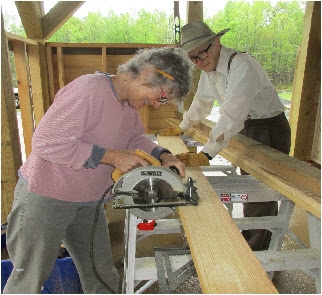Elderberry CoHousing
Monday, March 3, 2025
Because, a poem by Rosemerry Trommer
Saturday, August 31, 2024
“Why is cohousing so expensive? Tiny houses too?”
“Why are cohousing units so expensive? As chair of the Membership Committee at Elderberry, I hear that a lot, despite the fact that we seem to be the least expensive community in our region of North Carolina,1
Right now, Elderberry has our one tiny house above (325 square
feet) for sale. And we’ve heard that
question again. So, I looked up a
Forbes February 26, 2024 article “How Much Does A Tiny House Cost?”2 and this is
what it said - “On average, a tiny home costs about $50,000...The
cost you’ll end up paying for tiny homes depends on the size, quality and
details of the house you choose…. a custom tiny house with custom features and
build-ins can easily cost as much as $100,000 or more.”
Now, Elderberry’s tiny house is selling for $165K (its
appraised value; and it definitely fits the custom features mentioned above). But, where do the extra costs come from in
this house and in cohousing units in general?
In cohousing, as in condos, planned communities, HOAs, etc.
homeowners often jointly own community property as well, Therefore, that share of the entire property
is added to the cost of each house. But
cohousing really does share some additional, very special features.
We had some fun at Elderberry brainstorming the amenities included with our tiny house and you can apply many of these to homes in other cohousing communities.
First of all, it’s a permanent house – custom-designed with special environmental and accessibility features, sturdily built on a foundation on a lot that you own – not by developers who were interested in making a quick buck, but by fellow community members who plan to live here as neighbors for a long time. And these same folks designed, and continue to maintain, a ton of community features around their homes and this particular tiny home.
Here’s the fun part – a list of things you DO NOT NEED in
your home here because the community has already provided them in the common
house (which in this case is only about 33 steps from the door of our tiny
home).
· Washers & dryers
· Guest bedroom and bath
· A great big kitchen. full of every pot, pan, utensil, dish and appliance you could need (including shared freezer space)
· Big tables and a bunch of chairs in case your relatives/friends decide to party with you!
· Exercise equipment
·
A comfy seating area by the woodstove, as well
as a large-screen TV to share movies and broadcasts
·
Craft space, with a sewing machine
And there’s more –
·
Dog park with lots of room to run and play
·
Plenty of space to garden
·
Lawn chairs, swing, picnic tables, grills and
fire pit (the light brown house in the center of this photo is our tiny house)
·
Woodshop and a machine shop with every manner of
tool, bolt/screw/or whatsit you could ever need
·
Tool barn and garden shed with more equipment
than a hardware store – think ten wheelbarrows and seven weedwhackers and
ladders of every size!
Do these things add to the value and therefore the cost of
the house? Of course! But the other cool thing about cohousing is
that there’s not some manager or realtor who has no concern for whether I
personally can afford to live here.
Instead, here (and other cohousing communities) my neighbors are
consistently trying to keep costs down for all of us.
And last there are the intangible things to balance costs. This mostly consists of fellow members who—
· Can help you learn how to use all the things above and maybe even keep you from having to hire someone.
·
Will share what they have with you (from a pint
of half-&-half to a ride to the airport)
·
Will help you live a healthier life – eating,
exercising, gardening, working together and laughing
·
Give you a reason to come out and play – for free!
Okay, I know that if you’re interested in cohousing, you are
looking for more than an inexpensive kit house to just plop down somewhere, but I just wanted to give you a perspective on
why cohousing does cost more and what that money buys you. Come visit3 Elderberry’s tiny house or any other cohousing
community and see what I mean.
1
Elderberry is 20 minutes north of Durham; and our region has at least 10
cohousing communities.
2 https://www.forbes.com/home-improvement/contractor/tiny-house-cost/#:~:text=On%20average%2C%20a%20tiny%20home,researching%20common%20tiny%20house%20costs
3If
you’d like to visit, just e-mail me (Karolyn) at richard.mangeot@usa.net and
definitely look at https://www.elderberrycohousing.com/homes-available.html









